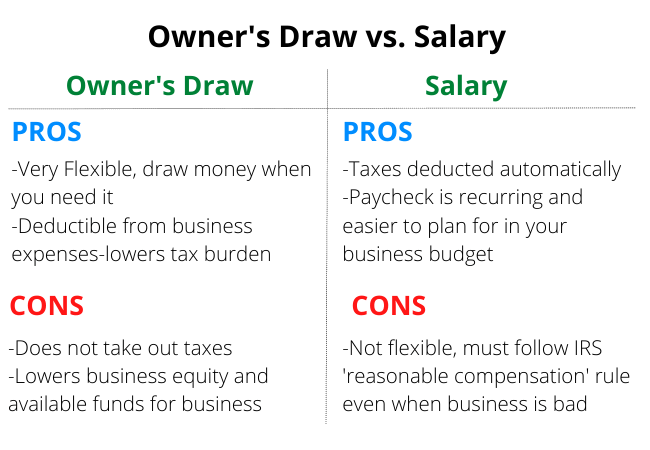Every business owner needs to bring home a paycheck, but it can be difficult to understand your options and choose the best approach, especially if you are a new business owner.
There are two main ways you can pay yourself as an owner: an owner's draw and taking a salary. In this article, we discuss the differences between these two methods and highlight the main considerations to bear in mind.
Related posts:
- How to Pay Yourself While Growing your Business
- Why Every Small Business Owner Needs an Emergency Fund
Difference Between Owner's Draw and Salary
While there are other ways business owners pay themselves, an owner's draw (or, a draw) and taking a salary are the two most common. Here is a definition of each method.
- Owner's draw: An owner's draw simply means that you draw money, either cash or means, from your business' profits on an as-needed basis. There is no regular amount or schedule that you adhere to. When you need money, you draw from business funds. This is more common with the self-employed that don't have employees.
- Salary: A salary is just like a typical paycheck that you received as an employee of another business. It's a set amount of money that you pay yourself regularly. You and your accountant first determine what reasonable compensation is for your position and industry, and then you give yourself a set weekly, bi-weekly, or monthly paycheck.
Pros and Cons of Owner's Draw and Salary
There are positive and negative aspects to both of these methods. An owner's draw is very flexible. Also, you can deduct your pay from business profits as an expense, which lowers your tax burden. However, it can reduce the business's equity and available funds, and you must account for self-employment taxes.
A salary is less flexible, but it already deducts taxes and it's a stable recurring expense to account for in your business budget.

How to Choose Between an Owner's Draw and a Salary
Many factors will impact your decision to choose a draw or salary. Three factors to be aware of are your business entity or structure, your owner's equity, and tax implications.
Consider Your Business Structure
Your business structure is the single biggest determining factor when it comes to choosing between an owner's draw and a salary. Generally speaking, you can only take an owner's draw if you have a sole proprietorship, partnership, or LLC. You can take a salary if you have a corporation or an LLC taxed as a corporation.
Understand Owner's Equity
Owner's equity is typically defined as the amount of money that would be returned to the owner (after all liabilities are paid) if the business is liquidated. Your equity comes from what you invest into the company–such as personal finances, equipment purchases, etc, plus business earnings.
If you decide to take an owner's draw, you cannot exceed your total equity. This is especially important if have partners, as taking too large of a draw can dip into your partner's equity–and salary.
Tax Implications
Do you want to account for income tax yourself or have it already taken out? If you elect to take a draw, you will need to set aside money yourself to pay self-employment tax. Many owners pay estimated tax quarterly to avoid penalties come tax season.
If you do not want to worry about taxes as much, paying yourself a salary with accounting software is a good way to go. This way, you get a consistent paycheck and your accountant (or software) can withhold your taxes. If you pay payroll tax, consider taking a salary so your accountant/software can track everyone's taxes in one place.
Final Thoughts
Choosing how to pay yourself is a big step in building a healthy, sustainable business. Whether you opt for a draw or a salary, the most important thing is to create a system that works for you and supports the long-term growth of your business.
Need help? Book a 1-on-1 call with a Skip expert.


